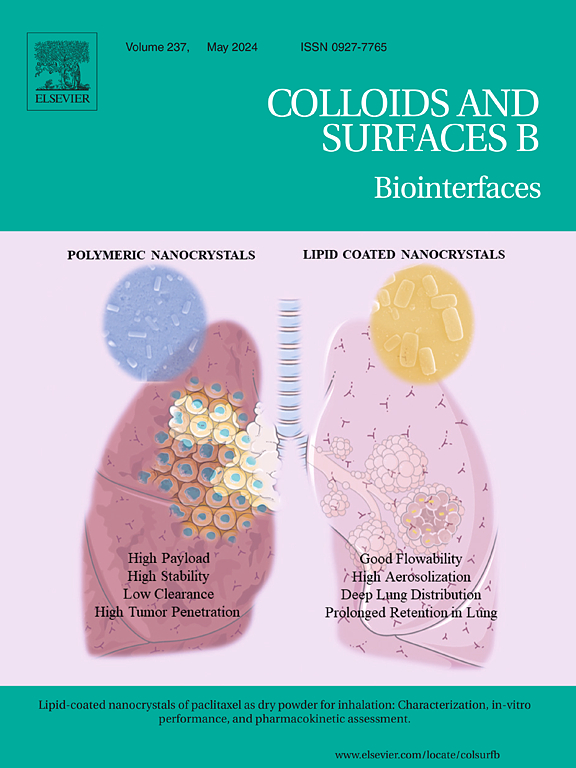Enamel remineralization enhancement by mesoporous bioactive glass (MBG) in commercial fluoride varnish and development of an MBG/fluoride chitosan composite hydrogel
IF 5.4
2区 医学
Q1 BIOPHYSICS
引用次数: 0
Abstract
With its excellent bioactivity and mesoporosity that endows controlled release of chemical or biological cues, mesoporous bioactive glass (MBG) is widely used in bone regeneration, yet less recognized in dentistry. This study investigates the enamel remineralization effect of MBG in commercial fluoride varnishes (FVs), and developes an MBG/fluoride chitosan composite hydrogel. MBG powders are added into commercial FVs (3M™ Clinpro™, Duraphat™) at different ratios to screen out the optimized proportion for mineralization. Further, an MBG/fluoride chitosan composite hydrogel (MBG/NaF/CS) has been developed at the optimized ratio, and its in vitro remineralization effect on tooth enamel after artificial saliva soaking for 1/3/5 days are evaluated via SEM, EDS and Vickers hardness test. Incorporation of 5 wt% MBG in FVs results in the most rapid and extensive hydroxyapatite (HAp) deposition within 24 h. MBG/NaF/CS hydrogel exhibits homogeneity instead of fluoride precipitation in NaF/CS hydrogel. The addition of MBG contributes to rapid, larger, and continuous fluorapatite (FAp) remineralization on enamel surface over time, and restores the hardness of enamel over normal level after 24 h. It is indicated that F- adsorption in MBG mesopores endowed the MBG/NaF/CS hydrogel an unreported continuous enamel remineralization effect up to 5 days under daily brushing. MBG enhances enamel remineralizing capacity of commercial FVs, and the novel MBG/fluoride chitosan composite hydrogel with continuous enamel remineralization effect represented a promising approach for caries management. This study may shed light on further application of MBG in dentistry.
介孔生物活性玻璃(MBG)增强商用氟清漆釉质再矿化及MBG/氟壳聚糖复合水凝胶的研制
介孔生物活性玻璃(MBG)具有优异的生物活性和介孔性,可控制化学或生物信号的释放,在骨再生中得到广泛应用,但在牙科领域的应用较少。研究了MBG在商用氟化清漆中的再矿化作用,研制了MBG/氟化壳聚糖复合水凝胶。将MBG粉末以不同比例添加到商用FVs (3M™Clinpro™,Duraphat™)中,以筛选出最佳的矿化比例。以优化配比制备MBG/氟化壳聚糖复合水凝胶(MBG/NaF/CS),通过扫描电镜(SEM)、能谱分析(EDS)和维氏硬度测试,评价人工唾液浸泡1/3/5 d后MBG/NaF/CS对牙釉质的体外再矿化效果。在FVs中掺入5 wt%的MBG会在24 h内形成最迅速和最广泛的羟基磷灰石(HAp)沉积。MBG/NaF/CS水凝胶表现为均匀性,而不是NaF/CS水凝胶中的氟化物沉淀。随着时间的推移,MBG的加入有助于牙釉质表面快速、较大且持续的氟磷灰石(FAp)再矿化,并在24 h后将牙釉质硬度恢复到正常水平以上。结果表明,MBG/NaF/CS水凝胶在每天刷牙的情况下具有连续5天的牙釉质再矿化作用。MBG增强了商品FVs的牙釉质再矿化能力,具有持续牙釉质再矿化效果的新型MBG/氟化物壳聚糖复合水凝胶是一种很有前景的龋齿治疗方法。本研究对MBG在牙科中的进一步应用具有一定的指导意义。
本文章由计算机程序翻译,如有差异,请以英文原文为准。
求助全文
约1分钟内获得全文
求助全文
来源期刊

Colloids and Surfaces B: Biointerfaces
生物-材料科学:生物材料
CiteScore
11.10
自引率
3.40%
发文量
730
审稿时长
42 days
期刊介绍:
Colloids and Surfaces B: Biointerfaces is an international journal devoted to fundamental and applied research on colloid and interfacial phenomena in relation to systems of biological origin, having particular relevance to the medical, pharmaceutical, biotechnological, food and cosmetic fields.
Submissions that: (1) deal solely with biological phenomena and do not describe the physico-chemical or colloid-chemical background and/or mechanism of the phenomena, and (2) deal solely with colloid/interfacial phenomena and do not have appropriate biological content or relevance, are outside the scope of the journal and will not be considered for publication.
The journal publishes regular research papers, reviews, short communications and invited perspective articles, called BioInterface Perspectives. The BioInterface Perspective provide researchers the opportunity to review their own work, as well as provide insight into the work of others that inspired and influenced the author. Regular articles should have a maximum total length of 6,000 words. In addition, a (combined) maximum of 8 normal-sized figures and/or tables is allowed (so for instance 3 tables and 5 figures). For multiple-panel figures each set of two panels equates to one figure. Short communications should not exceed half of the above. It is required to give on the article cover page a short statistical summary of the article listing the total number of words and tables/figures.
 求助内容:
求助内容: 应助结果提醒方式:
应助结果提醒方式:


